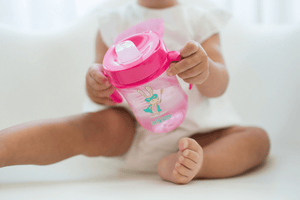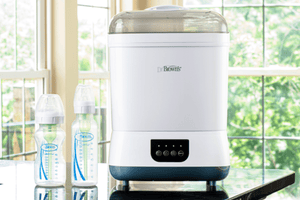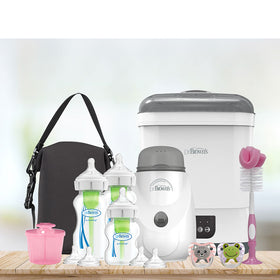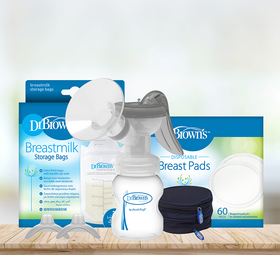
How to Soothe a Gassy Baby: Proven Techniques Backed by Parents & Science
(Dr Brown’s Australia Guide 2025)
What do you do? When your little one’s face turns red, legs pull up, and the crying just won’t stop. Few things tug at a parent’s heart like a baby who can’t be comforted; chances are, you’re dealing with trapped gas.
Research by PubMed suggests that more than half of infants experience at least one mild gastrointestinal symptom (such as gas, bloating, or regurgitation) in the first 6 weeks of life.”
The good news is, “Relief is possible”.
This short guide will teach you how to calm your baby’s tummy, restore comfort, and breathe a little easier yourself.
Why Do Babies Get Gassy?
Your baby’s digestive system is still learning how to work efficiently. During feeding, they often swallow air, especially if they’re feeding quickly, crying between sips, or using a bottle that allows bubbles to form. That trapped air collects in their tiny stomachs and intestines, causing pressure, pain, and tears.
Other common causes include:
-
An overly fast or slow milk flow
-
Overfeeding or irregular burping
-
Sensitivity to formula ingredients
-
Immature gut flora is still developing after birth
Unlike you, your baby can’t “fart on command”. So any swallowed air has to move slowly through their system before it can escape.
Signs of Gas Discomfort
It’s easy to confuse gas with colic or reflux. Gas pain is usually shorter-lived, and solvable with the right approach. While colic is typically prolonged crying (3 + hours a day), and reflux involves spit-up. Some of the easiest gassy-baby signs to spot include:
-
Pulling knees up toward the tummy
-
Clenched fists or stiffened body
-
Arched back or restless squirming
-
Frequent crying right after feeds
-
Passing wind but still seeming uncomfortable
5 Proven Ways to Relieve Baby Gas
1. Adjust Feeding Position
Keep your baby upright at a 45-degree angle during feeds to reduce air intake. Ensure the bottle’s nipple stays filled with milk, not air.
Try bottles engineered to prevent bubbles like the Dr Brown’s Options+™ Anti-Colic range, which uses an internal vent to stop air from mixing with milk.
2. Burp Halfway Through and After Feeds
Frequent, gentle burping helps release swallowed air before it becomes trapped, a small tweak that makes a big difference. Hold your baby over your shoulder with their tummy on your chest. Or sit baby on your lap, supporting their chin and rubbing their back in circles
3. Tummy Massage and Bicycle Legs
This encourages movement through the intestines and relieves pressure. Lay your baby on their back, gently rub the tummy in clockwise circles, and move their legs as if pedaling a bike. Avoid massaging immediately after feeding, wait about 20 minutes.
4. Warm Compress or Bath
Warmth relaxes abdominal muscles. Try placing a warm (not hot) compress over the tummy or giving a short warm bath before bedtime. Many parents find their baby settles more easily afterward.
5. Feeding Tools That Minimize Air Intake
This is crucial to prevent frequent gas issues. Use a slow-flow nipple for newborns to ensure they drink steadily, not gulping. Dr. Brown’s vent system allows air to bypass the milk, preventing air ingestion and reducing spit-up, burping, and fussiness, so you and your baby can enjoy feeding time. (Check our Anti-colic bottles)
When to See a Doctor or Health Nurse
Ordinarily, gas is usually harmless. But in extreme situations, please seek professional help if:
-
Crying lasts more than three hours daily despite soothing
-
Baby vomits often or refuses feeds
-
There’s blood in the stool
-
Weight gain is slow or declining
Your Child and Family Health Nurse or GP can rule out reflux or food intolerance. Except you’re that nurse/doctor, please don’t assume the cause of symptoms. It’s never “overreacting” to ask for help.
Preventing The Gas Before It Starts
Vented bottles, paced feeding, and frequent burping are consistently recommended by child-health experts. This is because studies published in pediatric journals have shown that reducing swallowed air during feeds significantly decreases gas-related discomfort.
According to the Australian Breastfeeding Association, ensuring a correct latch and a calm environment also helps digestion and prevents excess air intake.
Stacking these small changes can greatly improve your baby’s comfort and your peace of mind.
-
Feed calmly; avoid rushing or feeding while your baby is crying.
-
Burp frequently and after every feed.
-
Keep your baby upright for 10–15 minutes post-feed.
-
Mix formula gently—avoid shaking (which adds bubbles).
-
Schedule daily tummy time to strengthen core muscles and aid digestion.
Consistency, not perfection, is what matters most.
Quick Reference Checklist
Your Baby Gas Relief Toolkit
✅ Upright feeding position
✅ Burp midway and post-feed
✅ Clockwise tummy massage
✅ Bicycle legs between feeds
✅ Warm compress or short bath
✅ Anti-colic bottle system
✅ Patience, this stage passes
Conclusion
Every baby experiences gassy days; it’s part of learning to digest the world. While it can be exhausting, this phase is temporary, and how you handle it makes all the difference.
By combining gentle techniques, calm feeding habits, and supportive tools like Dr Brown’s Anti-Colic Bottles, you can make feeding a more peaceful, joyful experience for you and your baby.
Explore our full range of anti-colic bottles, slow-flow teats, and soothing accessories at drbrowns.com.au.







